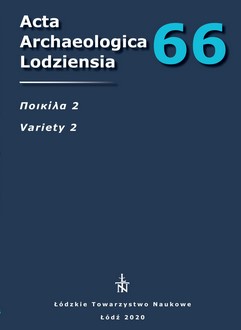GDZIE UKRYWANO MONETY WE WCZESNOŚREDNIOWIECZNYM KALISZU I JEGO OKOLICACH
WHERE COINS WERE HIDDEN IN THE EARLY MEDIEVAL KALISZ AND ITS VICINITY
Author(s): Adam KędzierskiSubject(s): Archaeology, Cultural history, Economic history, Local History / Microhistory, 6th to 12th Centuries
Published by: Łódzkie Towarzystwo Naukowe
Keywords: early Middle Ages; Kalisz; monetary circulation; silver hoards; trade routes; early medieval settlement;
Summary/Abstract: The aim of this paper is to list all the places in which early medieval coins were deposited in Kalisz and the surrounding area (Kalisz-Szałe, Kalisz-Zawodzie, Kalisz-Rajsków, Jastrzębniki and Kalisz Dobrzec). Recent research into the archaeological contexts of silver hoard assemblages deposited in the 10th, 11th, and the beginning of the12th century by Małgorzata and Mirosław Andrałojć, Patrycja Silska and Piotr Szyngiera has proved that deposits from Greater Poland were hidden principally outside of residential areas, either settlements and strongholds. Five assemblages are analyzed in the text. The places of their discovery are known in terms of their relationship to known areas of settlement of their time. The coins were been hidden in areas of early medieval settlements. Only the assemblage found at Kalisz-Dobrzec was deposed on the periphery of a former village. The majority of the assemblages come from large settlements which also functioned through the later Middle Ages down to modern times. Only the coins from Kalisz-Szałe were hidden at a site which was settled for a short duration of time. Hoards from Kalisz and its surroundings were hidden in settlements located on important trade routes, which in early medieval times connected Kalisz with the East and the North.
Journal: Acta Archaeologica Lodziensia
- Issue Year: 2020
- Issue No: 66
- Page Range: 15-26
- Page Count: 12
- Language: Polish

